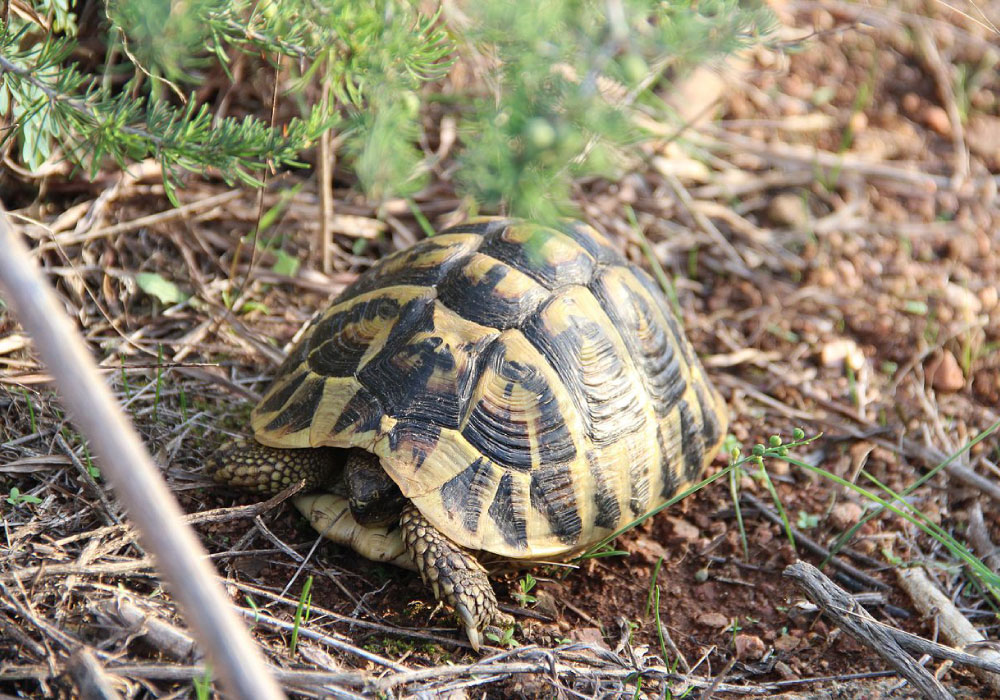All About Hermann’s Tortoises

Summary
Hermann’s tortoises are one of the most popular species of tortoise to keep as pets and it’s easy to see why. They have a level of individual personality that is rare in reptiles, and they can be very charming and funny. They develop a bond of companionship with their owner, and you will get to know their individual quirks, likes, and dislikes. Hermann’s tortoises are part of a group of tortoises referred to as “Mediterranean tortoises”, in the wild, Hermann’s tortoises live in rocky hillsides and oak and beech forests of the Mediterranean. Due to habitat destruction and poaching for the pet trade, Hermann’s tortoises are (Dec/2012) IUCN Red list category – near threatened (don’t worry, ours are captive bred). Hermann’s tortoises are microchipped and require specific CITES documentation to be legally kept and sold in the UK, please ask a friendly member of staff for more information regarding this.
- Hermann’s Tortoises rarely grow larger than 18 cm (7.5 inches)
Life span:
- The oldest known Hermann’s tortoise in the UK was over 110 years! This is a rare case, but a happy and healthy Hermann’s tortoise should be expected to live for over 50 years so they are certainly a long term commitment.
Considerations before purchases
- • Who will look after your new pet if you are away?
- • Can you provide fresh food for your pet?
- • Are you prepared to take on an animal that could live for 50 years?
- • Is the rest of the family happy to live with a tortoise?
- • Can you afford all the equipment necessary to keep your pet happy?
- • Have you done your research on Hermann’s tortoises and their relevant care?
Handling
Tortoises do not generally enjoy being handled. Care should be taken to avoid dropping your tortoise whilst handling. They have very strong legs, so support your tortoise firmly at all times whilst handling. Approximately 10-15 minutes 3-4 times a week is a suitable amount of time for handling, but this may vary depending on the particular tortoise. Do not handle your tortoise for at least 24 hours when you first take them home to allow them to settle in to the new surroundings.
It is important for hygiene reasons to wash your hands with an anti-bacterial hand wash before and after handling your tortoise.
Feeding & Water
These tortoises need to be provided with a diet high in fibre and calcium, but low in protein and carbohydrates. Remember to wash food items thoroughly to remove residues such as fertilisers or pesticides and lightly sprinkle the food with a calcium carbonate supplement such as calcidust every meal. Also on alternate days, the food must be lightly dusted with a vitamin D3 supplement such as Nutrobal. It is also beneficial to offer cuttlefish bone which not only provides a calcium source but also helps keep the beak trimmed.
A large shallow bowl of clean fresh water must always be available and it will need to be large enough for your tortoise to bath in but not so deep as to pose a risk of drowning. The water level should be just deep enough to submerge the plastron (bottom half of the shell). In addition to the water bowl, a tortoise will require a bath at least twice a week in tepid water as well as flush out any wastes such as faecal and uric matter.
Enclosure
Even though it is believed that tortoises can live outdoors and are capable of surviving the various weather conditions, the limited period of warm weather and sunshine in the UK is not really enough for the tortoise to maintain correct husbandry. Although vivaria are commonly sold to house Hermann’s tortoise, they are best suited to a tortoise table set-up. Tortoise tables allow excellent airflow and a low humidity level; which is ideal for Hermann’s tortoises. The size of the tortoise table will vary depending on the size of the tortoise; Tortoises under 5 years approx: 90 cm x 45 cm x 21.5 cm (length x width x height) and tortoises over 5 years approx: 120cm x 90cm x 21.5cm (length x width x height). Unlike most reptile pets, tortoises need a lot of room and so many experts recommend that Hermann’s tortoises have access to both indoor and outdoor enclosure. An outdoor area for tortoises doesn’t have to be anything special and doesn’t need to cost a fortune. A small animal wire can be used throughout the warmer months to allow your tortoise to benefit from natural unfiltered sunlight.
Heating & Lighting
Hermann’s tortoises are cold-blooded reptiles, so they rely on the heat from their external surroundings to regulate their body temperature. To provide the heat and light that your Hermann’s tortoise needs, we recommend using a self-ballasted mercury vapour lamp like the Zoo Med Power Sun UV bulbs, which provides both heat and UV-B light. They will need to be fitted into an appropriate reflector holder, like the Zoo Med Deep Dome Lamp Fixture, and should be suspended at one end of a tortoise table using a Zoo Med Reptile Lamp Stand at the distance that will supply the correct temperature. You should be aiming for a temperature of around 32˚C to 38˚C directly under the lamp. The temperature at the far end of the table away from the lamp should be around 15˚C to 22˚C, room temperature is usually all that is required to keep your tortoise happy in this part of their enclosure. You will also need a thermometer so that you can monitor the temperature of your tortoise’s enclosure. A digital thermometer, which is far more accurate than a dial-type thermometer and allows you to gauge the temperature for both the “warm” area and the “cool” area. Usually a tortoise will require heat and light for around 12-14 hours her day. Additional heating is not required during the night tim as Hermann’s tortoises are quite tolerate to lower temperatures so a drop to normal room temperature overnight will not harm them.
Substrate
Tortoises love to dig and bury so ProRep Tortoise Life makes an excellent substrate. It has been specifically designed to replicate arid habitats where Hermann’s tortoises are from, its texture and moisture retention replicates their environment perfectly. Enough substrate should be provided so the tortoise can bury itself, with young tortoises, a depth of around 5cm will be adequate but will need to increase as your tortoise grows. It’s a good idea to use a ProRep Hand Sprayer to spray the substrate with water on a daily basis, this will help keep the substrate slightly moist and help to keep the dust down.
Final Remarks
Hermann’s tortoises can make friendly long-lived additions to your family if they are provided with their essential care requirements. Pregnant women, young children and people with weakened immune systems should consult a doctor before exposure to any reptile. Please ask a friendly member of staff for advice if you require further information.
Check List
- • Secure enclosure
- • Basking Bulb Heat source
- • Thermostat
- • Thermometer
- • Water bowl
- • Hides
- • Reptile disinfectant
- • Food
- • Substrate
- • Lighting
- • Décor
- • Hand sanitiser
- • Water conditioner
- • Hermann’s book
- • Supplements


